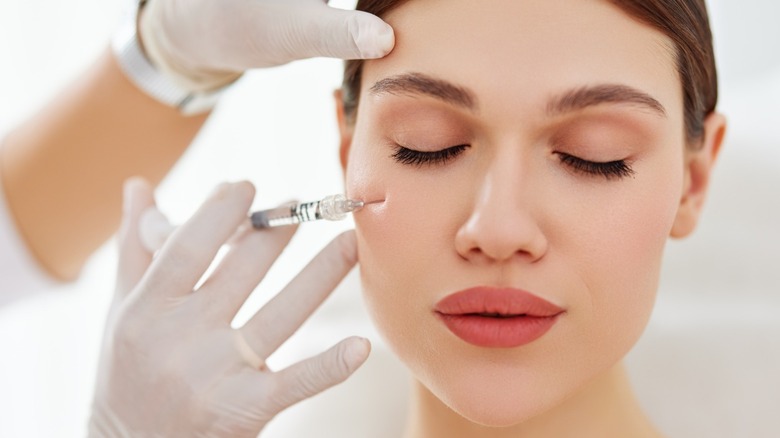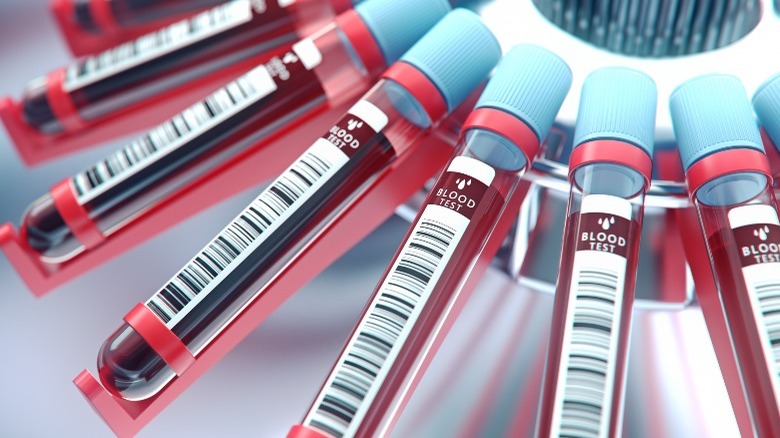Your Guide To PRF Injections To Treat Skin Concerns
Close to $17 billion was spent on plastic surgery in the U.S. in 2020, per The American Society of Plastic Surgeons. The report shows that people love Botox and filler. But, cosmetic procedures are not used for cosmetic procedures alone. Botox, for example, has been administered to alleviate chronic migraines, spasms, and more, per The Mayo Clinic. And as medical technology continues to evolve, more and more cosmetic procedures borrow from medical procedures to introduce them to the market. One procedure in particular is gaining popularity.
A PRF (or "platelet-rich fibrin") injection is a procedure in which the skin is injected with a product of your own blood to rejuvenate the skin. Per double-board certified plastic surgeon Dr. Michael Somenek, PRF injections are "the next generation" of PRP (or "platelet-rich plasma") injections, which are most often used to treat sports injuries (via Byrdie). PRF injections are made from a natural product — your own blood. Here's what you should know about them.
PRF injections could be tough for the squeamish
Fibrin is the real star of PRF injections, though each component in the injection works together, Pure Dermatology NOLA explains. Per Britannica, "fibrin is an insoluble protein that is produced in response to bleeding and is the major component in the blood clot." However, it will not produce the same volume that Botox or fillers can, and should not be used as a replacement for the treatment, according to Byrdie. (There are certain things Botox can and can't do for you, either.) Instead, PRF injections can be used to treat acne scars that require help healing, smooth wrinkles, and rejuvenate and lighten the under-eye area, per Aesthetics Med Spa.
PRF injections are not just injections of your raw blood, so to speak. First, a relatively substantial amount of blood could be drawn, around 40 milliliters, as 1 to 1.5 milliliters of injectable liquid is extracted per every 10 milliliters of blood, and about 3 to 4 milliliters are needed for full-face injections (via Indian Dermatology Online Journal). Then, the blood is run through a centrifuge at a low speed. Board-certified dermatologist Dr. Brendan Camp told Byrdie, "The absence of an anticoagulant in the tube allows the formulation of a spongy, gel-like product." The product is full of white blood cells, stem cells, fibrin, and platelets, which together stimulate growth factors in the skin. Once processed, the product should be injected right away.
PRF injections offer long-term benefits
Treatment will likely consist of multiple sessions to achieve the desired results, per Byrdie. The benefits of PRF injections can be long-term, up to a year, according to Dr. David W. Kim, M.D. A topical numbing agent is typically used during the treatment.
Before treatment, it is best not to drink alcohol for at least a week, to stop taking anti-inflammatory medicines such as Ibuprofen or Advil for at least two weeks, and to stop taking Omega-3 supplements or vitamin E for at least a week, as all of these components could reduce the effect of the PRF injection. Just as there are questions you should ask a doctor before getting Botox, the same principle applies to PRF treatments. For example, check with your doctor if you have concerns about medications you may be prescribed ahead of the procedure. Of course, it is always a great idea to drink plenty of water. And while bruising and swelling are to be expected at the injection site, consult your doctor post-treatment should you have further concerns.


